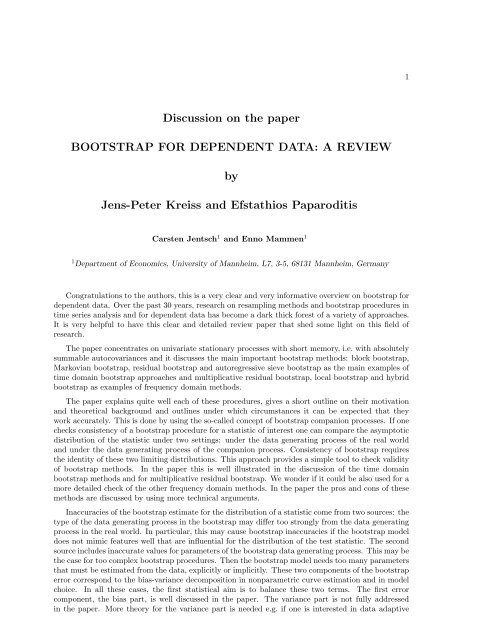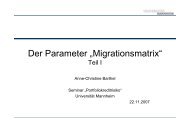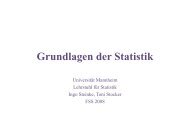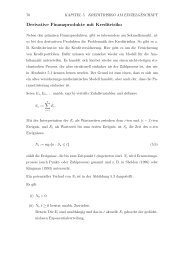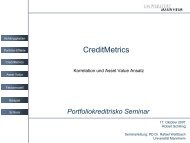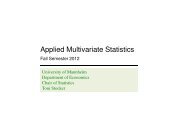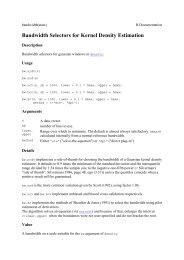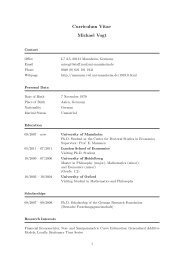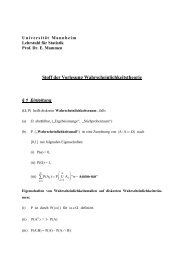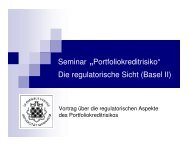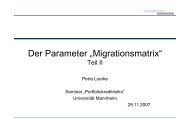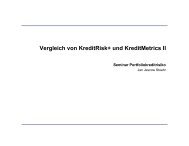Discussion on the paper BOOTSTRAP FOR DEPENDENT DATA: A ...
Discussion on the paper BOOTSTRAP FOR DEPENDENT DATA: A ...
Discussion on the paper BOOTSTRAP FOR DEPENDENT DATA: A ...
You also want an ePaper? Increase the reach of your titles
YUMPU automatically turns print PDFs into web optimized ePapers that Google loves.
<str<strong>on</strong>g>Discussi<strong>on</strong></str<strong>on</strong>g> <strong>on</strong> <strong>the</strong> <strong>paper</strong><br />
<strong>BOOTSTRAP</strong> <strong>FOR</strong> <strong>DEPENDENT</strong> <strong>DATA</strong>: A REVIEW<br />
by<br />
Jens-Peter Kreiss and Efstathios Paparoditis<br />
Carsten Jentsch 1 and Enno Mammen 1<br />
1 Department of Ec<strong>on</strong>omics, University of Mannheim, L7, 3-5, 68131 Mannheim, Germany<br />
C<strong>on</strong>gratulati<strong>on</strong>s to <strong>the</strong> authors, this is a very clear and very informative overview <strong>on</strong> bootstrap for<br />
dependent data. Over <strong>the</strong> past 30 years, research <strong>on</strong> resampling methods and bootstrap procedures in<br />
time series analysis and for dependent data has become a dark thick forest of a variety of approaches.<br />
It is very helpful to have this clear and detailed review <strong>paper</strong> that shed some light <strong>on</strong> this field of<br />
research.<br />
The <strong>paper</strong> c<strong>on</strong>centrates <strong>on</strong> univariate stati<strong>on</strong>ary processes with short memory, i.e. with absolutely<br />
summable autocovariances and it discusses <strong>the</strong> main important bootstrap methods: block bootstrap,<br />
Markovian bootstrap, residual bootstrap and autoregressive sieve bootstrap as <strong>the</strong> main examples of<br />
time domain bootstrap approaches and multiplicative residual bootstrap, local bootstrap and hybrid<br />
bootstrap as examples of frequency domain methods.<br />
The <strong>paper</strong> explains quite well each of <strong>the</strong>se procedures, gives a short outline <strong>on</strong> <strong>the</strong>ir motivati<strong>on</strong><br />
and <strong>the</strong>oretical background and outlines under which circumstances it can be expected that <strong>the</strong>y<br />
work accurately. This is d<strong>on</strong>e by using <strong>the</strong> so-called c<strong>on</strong>cept of bootstrap compani<strong>on</strong> processes. If <strong>on</strong>e<br />
checks c<strong>on</strong>sistency of a bootstrap procedure for a statistic of interest <strong>on</strong>e can compare <strong>the</strong> asymptotic<br />
distributi<strong>on</strong> of <strong>the</strong> statistic under two settings: under <strong>the</strong> data generating process of <strong>the</strong> real world<br />
and under <strong>the</strong> data generating process of <strong>the</strong> compani<strong>on</strong> process. C<strong>on</strong>sistency of bootstrap requires<br />
<strong>the</strong> identity of <strong>the</strong>se two limiting distributi<strong>on</strong>s. This approach provides a simple tool to check validity<br />
of bootstrap methods. In <strong>the</strong> <strong>paper</strong> this is well illustrated in <strong>the</strong> discussi<strong>on</strong> of <strong>the</strong> time domain<br />
bootstrap methods and for multiplicative residual bootstrap. We w<strong>on</strong>der if it could be also used for a<br />
more detailed check of <strong>the</strong> o<strong>the</strong>r frequency domain methods. In <strong>the</strong> <strong>paper</strong> <strong>the</strong> pros and c<strong>on</strong>s of <strong>the</strong>se<br />
methods are discussed by using more technical arguments.<br />
Inaccuracies of <strong>the</strong> bootstrap estimate for <strong>the</strong> distributi<strong>on</strong> of a statistic come from two sources: <strong>the</strong><br />
type of <strong>the</strong> data generating process in <strong>the</strong> bootstrap may differ too str<strong>on</strong>gly from <strong>the</strong> data generating<br />
process in <strong>the</strong> real world. In particular, this may cause bootstrap inaccuracies if <strong>the</strong> bootstrap model<br />
does not mimic features well that are influential for <strong>the</strong> distributi<strong>on</strong> of <strong>the</strong> test statistic. The sec<strong>on</strong>d<br />
source includes inaccurate values for parameters of <strong>the</strong> bootstrap data generating process. This may be<br />
<strong>the</strong> case for too complex bootstrap procedures. Then <strong>the</strong> bootstrap model needs too many parameters<br />
that must be estimated from <strong>the</strong> data, explicitly or implicitly. These two comp<strong>on</strong>ents of <strong>the</strong> bootstrap<br />
error corresp<strong>on</strong>d to <strong>the</strong> bias-variance decompositi<strong>on</strong> in n<strong>on</strong>parametric curve estimati<strong>on</strong> and in model<br />
choice. In all <strong>the</strong>se cases, <strong>the</strong> first statistical aim is to balance <strong>the</strong>se two terms. The first error<br />
comp<strong>on</strong>ent, <strong>the</strong> bias part, is well discussed in <strong>the</strong> <strong>paper</strong>. The variance part is not fully addressed<br />
in <strong>the</strong> <strong>paper</strong>. More <strong>the</strong>ory for <strong>the</strong> variance part is needed e.g. if <strong>on</strong>e is interested in data adaptive<br />
1
choice of an optimal or near-optimal bootstrap approach. The questi<strong>on</strong> how <strong>on</strong>e chooses <strong>the</strong> bootstrap<br />
procedure with <strong>the</strong> best bias-variance tradeoff seems to be ra<strong>the</strong>r unclear. The choice of bootstrap<br />
tuning parameters has been studied, e.g. choice of <strong>the</strong> block size for block bootstrap. But how to<br />
choose data adaptively between several bootstrap procedures seems to be an open research questi<strong>on</strong>.<br />
This requires <strong>the</strong> study of new double bootstrap or crossvalidati<strong>on</strong> techniques, perhaps inspired by<br />
<strong>the</strong>oretical work <strong>on</strong> data-adaptive smoothing parameter selecti<strong>on</strong> in n<strong>on</strong>parametric curve estimati<strong>on</strong><br />
or by recent <strong>the</strong>oretical progress in model selecti<strong>on</strong>.<br />
We also would like to comment fur<strong>the</strong>r <strong>on</strong> <strong>the</strong> bias comp<strong>on</strong>ent of <strong>the</strong> bootstrap error. Our discussi<strong>on</strong><br />
takes <strong>the</strong> linear process bootstrap (LPB) as an example. The LPB introduced by McMurry and<br />
Politis (2010) uses tapered and banded autocovariance matrix estimators of <strong>the</strong> whole (univariate)<br />
data stretch and i.i.d resampling of appropriately standardized residuals to generate bootstrap observati<strong>on</strong>s.<br />
C<strong>on</strong>sistency of <strong>the</strong> LPB was established in McMurry and Politis (2010) for <strong>the</strong> sample mean.<br />
There it was shown that MA processes can be resampled without estimating <strong>the</strong>ir coefficients explicitly.<br />
This is usually d<strong>on</strong>e by numerical optimizati<strong>on</strong> or by <strong>the</strong> innovati<strong>on</strong> algorithm. Both procedures<br />
are much more involved than estimating for example AR coefficients. Validity of <strong>the</strong> LPB, including<br />
a multivariate versi<strong>on</strong>, is shown in Jentsch and Politis (2011). They show that <strong>the</strong> multivariate LPB<br />
works also for spectral density estimati<strong>on</strong>, but that, in general, it fails for sample autocovariances.<br />
With <strong>the</strong> previous discussi<strong>on</strong> in mind, this is not surprising, because <strong>the</strong> LPB is designed to capture<br />
<strong>the</strong> covariance structure of <strong>the</strong> underlying process and <strong>the</strong> limiting distributi<strong>on</strong> of sample autocovariances<br />
is known to depend also <strong>on</strong> higher order characteristics of <strong>the</strong> true DGP. Even in <strong>the</strong> univariate<br />
case and under assumed linearity, this is still <strong>the</strong> case. However, as Jentsch and Politis (2011) show,<br />
c<strong>on</strong>sistency of <strong>the</strong> LPB holds for univariate, causal and invertible linear processes for higher order<br />
statistics as e.g. autocovariances. At first sight, this may seem to be surprising, because c<strong>on</strong>trary to<br />
fully n<strong>on</strong>parametric bootstrap methods as e.g. <strong>the</strong> block bootstrap, <strong>the</strong> LPB mimics by c<strong>on</strong>structi<strong>on</strong><br />
<strong>on</strong>ly <strong>the</strong> sec<strong>on</strong>d order structure of <strong>the</strong> DGP and not its entire dependence structure. But by taking<br />
a closer look and particularly in comparis<strong>on</strong> to <strong>the</strong> prominent autoregressive sieve bootstrap [cf. <strong>the</strong><br />
discussi<strong>on</strong> in Kreiss, Paparoditis and Politis (2011)], which is str<strong>on</strong>gly related to <strong>the</strong> LPB approach,<br />
this result fits in <strong>the</strong> existing literature. Heuristically, <strong>the</strong> LPB remains valid in this case due to a<br />
triangular shape of <strong>the</strong> matrix A that (approximately) transforms <strong>the</strong> vector of residuals (e1, . . . , en) ′<br />
by pre-multiplicati<strong>on</strong> to <strong>the</strong> vector of observati<strong>on</strong>s (X1, . . . , Xn) ′ . Thanks to <strong>the</strong> triangular shape of<br />
A and under invertibility, this matrix fits properly toge<strong>the</strong>r asymptotically with <strong>the</strong> Cholesky matrix<br />
that is involved in <strong>the</strong> bootstrap algorithm. Eventually, this implies c<strong>on</strong>sistency for <strong>the</strong> LPB in this<br />
case. In summary, we see in this example that c<strong>on</strong>sistency c<strong>on</strong>siderati<strong>on</strong>s for bootstrap are often<br />
much more involved and complex as <strong>on</strong>e would expect from an analysis using bootstrap compani<strong>on</strong><br />
processes.<br />
To summarize, we think that this review <strong>on</strong> bootstrap for dependent data gives a very detailed and<br />
informative discussi<strong>on</strong> of <strong>the</strong> state of <strong>the</strong> art. In our opini<strong>on</strong> future work is needed for an understanding<br />
of <strong>the</strong> bias-variance performance of bootstrap procedures. Fur<strong>the</strong>rmore, this knowledge must be used<br />
to develop efficient data adaptive methods that choose between different bootstrap procedures.<br />
References<br />
[1] Jentsch, C. and Politis, D.N. (2011). The multivariate linear process bootstrap. Preprint.<br />
[2] Kreiss, J.-P., Paparoditis, E. and Politis, D.N. (2011). On <strong>the</strong> range of validity of <strong>the</strong> autoregressive<br />
sieve bootstrap. Annals of Statistics (in press).<br />
[3] McMurry, T.L. and Politis, D.N. (2010). Banded and tapered estimates for autocovariance matrices<br />
and <strong>the</strong> linear process bootstrap. Journal of Time Series Analysis 31, 471–482.<br />
2


